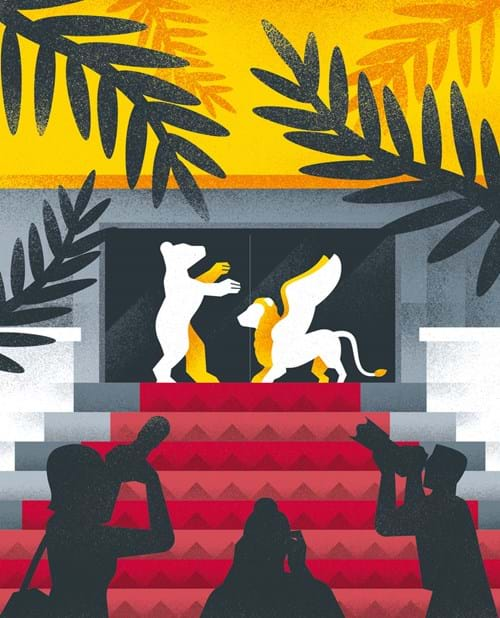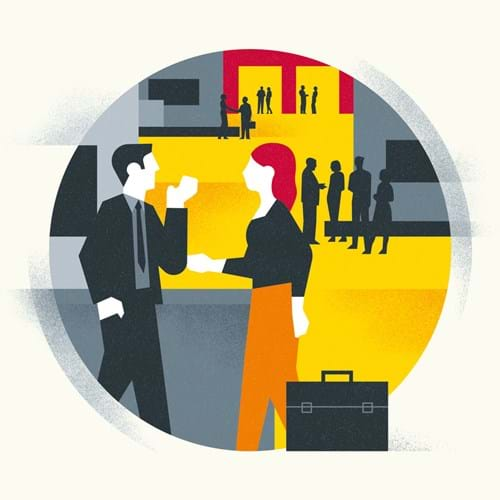DEAR READER,
When this issue of TAKE comes out, the Venice International Film Festival will be just around the corner, Cannes will have managed to present its films with some delay (and strict safety measures), and the one-off Berlinale summer festival will have also taken place. So it seems like everything is slowly getting back to normal. But the past year will leave a mark on the upcoming festivals for a long time to come. When suddenly faced with the choice of dropping out altogether or offering a curated online program, most festivals used the involuntary break to stop for a moment and question what their actual mandate is. Against the backdrop of all the restrictions, interruptions, failures and detours that have plagued festivals for over a year now, we want to use the opportunity to likewise take stock in this dossier – and reflect on the tasks, passion and mission of film festivals.
Florian Krautkrämer
TAKE #13 Editor-in-Chief
Un Certain Regard. Festivals in the Pandemic Age
In 2020, the Berlinale was still lucky. The world’s largest public festival normally kicks off in February, shortly after Sundance and Rotterdam, followed by numerous festivals of all sizes and then, a few weeks later, Cannes Film Festival. But there’s been no normality since February 2020. And so, for quite some time the Berlinale was the last event of its kind to be held in cinemas, sold out to the last seat and without hygiene measures or protective masks. Only in retrospect did it become clear what a close call it was: the program was carried out completely, despite a two-week postponement to the end of February, in the same moment that some countries were already closing their borders. And it’s intriguing to imagine how long it will take before we return to the feeling of normality that still prevailed in the cinemas back then: queues of waiting people and a bustling European Film Market. Because, since then, festivals have been hit by their greatest crisis ever. Nothing can shake a festival as much as the prohibition of a physical presence – neither digitization nor splitting off of sections, neither scandalous films nor ill-considered comments made by directors nor last-minute cancellations by filmmakers.

Film festivals are much more than a mechanism for screening films. Depending on their size and focus, they take on important tasks that would be nearly impossible to perform otherwise. The A-list festivals such as Berlin, Cannes and Venice, together with Sundance and Toronto, are first and foremost industry events. They are a venue for the film industry to present its latest works. Festival awards can be pivotal for the careers of filmmakers. They facilitate the creation of new films and increase the visibility of older ones. Far more films are shown at the accompanying markets than in the actual festival program. The focus here is not only sales and deals for completed projects, but also on establishing new contacts: editors meet directors, producers from different countries get to know each other in order to co-produce in the future. Film is a people business – and that is more evident at a festival than anywhere else. An online version of an illustrious festival cannot therefore be a permanent option. The 2020 Cannes International Film Festival was cancelled for this very reason.
Croatian producer Ankica Jurić Tilić emphasized this at IDM’s INCONTRI Film Conference, whose Focus panels were devoted to Eastern European countries. For Jurić Tilić, the great strength of festivals sometimes lies far removed from the actual cinema hall: “The lively exchange in bars, in the main festival hotels and at receptions is at least as important as the co-production meetings that many festivals now offer,” she says.
AN ASTOUNDINGLY QUICK ADAPTATION
Alberto Barbera, the Venice Film Festival’s artistic director, made a similar point at an INCONTRI panel dedicated to the future of festivals: “I’m sure that in-person festivals will become even more important in the future, because in recent months it has become clear what has been lost through an online-only version,” Barbera said. For the A-list festivals and the films they show, this is marketing, first and foremost: the walk down the red carpet, the crackling excitement of waiting and presenting, the press conferences and the atmosphere created when thousands of people with similar interests stay in the same place. None of that can be reproduced online.
Piera Detassis, president of the Academy of Italian Cinema, which bestows the David di Donatello award, agreed with Barbera. “Our awards went online in 2020,” Detassis said, “and since then I’ve felt a need in the industry for a closeness that was previously unheard of on such a scale – as well as a desire to focus more on the essentials going forward.”

“The ceremonies will have to make changes that reflect that,” added Matthijs Wouter Knol, director of the European Film Academy, “but the awards will maintain their importance.”
Yet it’s truly astounding – and a tremendous achievement – how quickly the film festivals were able to adapt to the new situation and stream their films, something very few had any previous experience doing. Venice was the only one of the three major festivals that had been offering an online section for several years, allowing festivalgoers to buy a limited number of tickets for films in the Orizzonti section, and stream them at home. A solution that many others had to become quickly accustomed to.
Just a few weeks after the 2020 lockdown, the first online festivals appeared where you could buy access to the films for a limited amount of time. Many festivals did not limit themselves to screening the actual films, but also showed introductions and discussions, trying to maintain what actually sets them apart: interaction between cinema, creatives and the public.
They relied on an infrastructure that was pre-existing but still led a niche existence, showing their films via Vimeo or Festival Scope – both platforms through which on-demand video has been accessible for some time. Later on, specialized new offerings developed specifically out of the lockdown experience, such as Cinema Lovers in Germany. If one disregards the lack of on-site exchange, the experience that festivals and audiences have gained with online festivals is actually quite good. That’s especially true for events that target a specific community of interest, such as festivals showing LGBTQ films or those curated by and for minorities: here, this kind of fallback option is important to keep the regular audience and the community together through the discourse around the films.
An online solution is far from possible for every event, however. Festivals that specialize in screening old 35-mm films, for example, will have to wait until they can once again show their treasures in cinemas. And there’s also a danger associated with creating an expectation that festivals should always offer part of their program online. Critics warn against buying into the idea of greater reach – something that might seem particularly attractive for smaller, local festivals: This artificial mode of permanent availability ultimately also deprives a festival of its exclusivity.
WHERE FILM CULTURE MEETS
Lukas Pitscheider is the director of Dolomitale, the Film Festival of the Dolomites, whose competition focuses on Alpine films and takes place annually at the end of September. Pitscheider is convinced that the demand for in-person film events will be huge as soon as regulations allow for it again. “Our goal is to bring people together, pull them away from the small screens,” he says. Because the Dolomitale takes place in September, the 2020 festival occurred, albeit with restrictions and safety measures. “We had even planned a drive-in cinema for the sake of safety – we were simply terrified of having to do the festival online,” Pitscheider laughs. Interestingly, his organizing team was contacted by numerous streaming service providers. “But, I mean, we don’t even have a cinema yet! It’d be hard to reconcile the idea that a long-term goal of our work is to open a cinema locally – and then switch to streaming,” says the director, whose 2021 festival is just around the corner.
Larger local festivals needed to find other solutions: Bolzano Film Festival Bozen opted to go online in 2021, after the event had to be canceled a year earlier because it fell right into the first lockdown in April. “It was a phase of total shock,” recounts festival director Helene Christanell. “After all, we had already prepared everything and had committed to the audience, films and sponsors.” They kept trying to work out a way to do it all the way until the end of November, when they finally gave up and canceled it completely. The 2020 festival would have been the 34th, now 2021 is number 34. While the event couldn’t be held in person again this year, Christanell’s team had more time to prepare for going online. They were also able to draw on the experience of other festivals and use Pantaflix, a proven streaming partner.
A public festival like Bolzano aims its program mainly at the local people. Going online made it possible to reach significantly more viewers in the region who might not otherwise have made the trip to the South Tyrolean capital to watch a film. One important feature of the Bolzano Festival is dialogue between audience members and creatives, which easily arise within the intimate setting of the Film Club cinema in the city center, before and after the screenings. For this reason, the festival pre-recorded film talks and posted them online with the films; they’re still available on the festival website. “But without the prospect of an on-site festival, an online event isn’t attractive,” Christanell says. “One of our goals is to attract new, young audiences to cinema so it’s a tremendously important hub for encounters between film, audiences and guests.”
Gaining the interest of new cinema audiences and thus spreading the idea of film culture: this too is an important role for film festivals, and one that is not to be underestimated. And it is also a way to stand out from the streaming crowd, as Matthijs Wouter Knol pointed out at the INCONTRI panel. The Berlinale traditionally attaches great importance to outreach, an idea that led to the founding of the Forum of New Cinema and, in recent years, the Talents section, a vibrant meeting place for up-and-coming filmmakers.
For Carlo Chatrian, the Berlinale’s new artistic director, it was therefore a priority to organize an open-air program of this year’s Berlinale selection, which was screened for industry members only to a very limited extent in March, in addition to the Film Market, which took place online for five days in March this year. The streamed film market received a very positive response from both buyers and producers: The latter received a minute-by-minute evaluation of who had watched their films. The Berlinale will certainly continue this online program as a supplement in the coming years. But the summer open-air program will hopefully remain a one-off – “even if it’s a home game, so to speak,” joked Chatrian at the INCONTRI panel, whose many years of experience as director of the open-air Locarno Film Festival helped him bring a lot to the table.
Local audiences are enormously important for the Berlinale, more so than for other A-list festivals. A film screened here can attract up to 20,000 attendees; the enormous volume of films programmed each year is only possible because of strong audience interest and numerous venues throughout the city. “In future, we must consider how to make these social gatherings possible,” Chatrian indicated. Meanwhile, this year’s Berlinale jury awarded the Golden Bear to Radu Jude’s Bad Luck Banging or Loony Porn, one of the first films set against the backdrop of the current pandemic in which the protagonist is seen with a mask on her face most of the time – a clear indication of changing realities, even on-screen.